What’s in a name, Shakespeare famously asked. He was, of course, referring to a rose. But we might ask the same about the word, minivan. Once one of the most popular body styles on U.S. roads, sales have slumped sharply in recent years as style-conscious buyers have migrated to SUVs and crossovers.
Honda, however, has come up with an interesting solution. Give buyers a minivan and just call it something else. Officially, the 2016 Honda Pilot is a utility vehicle. But for all intents and purposes, it’s a minivan minus the sliding doors.
First introduced in 2003 and redesigned six years later, the third-generation Honda Pilot is more than just an update. It adopts a much more stylish exterior, an even more lavish interior, and plenty of new safety and creature comfort technologies. What stays the same is Pilot’s focus on providing the sort of comfort, functionality and flexibility that, in years past, would have drawn buyers to conventional minivans, including Honda’s own Odyssey model.
That’s not to say the 2016 Honda Pilot is without flaw. It does have its issues, some niggling and modest, a few more noticeable. But, on the whole, the gen-3 model is likely to live up to the maker’s expectations and become one of its pillar products, alongside the Accord and Civic lines.
Officially unveiled at the Chicago Auto Show last February, the ’16 Pilot revealed what Honda officials declared a “dramatic shift” in styling. It boasts more curve to its silhouette, with a creased hood designed to emphasize power, and more sculpting to its fenders and doors. The new model gets a more stylish, three-dimensional approach to the older Pilot’s triple-bar grille, as well as a more aggressive fascia.
(Click Here for a review of the newest Honda CR-V.)
Overall, the new model stays close to the dimensions of the gen-2 Pilot, picking up just 3.5 inches in length. Most of that goes into the cabin, and the added inches make it easier to gain access to the third row, especially with a new one-touch second-row seating design that’s easier to fold out of the way.
Like the outgoing model, the 2016 Pilot can be ordered in either 7- or 8-seat configuration, depending on whether you want that middle row with a pair of captain’s chairs or a bench seat. As with a number of other recent Honda products, seating can be reconfigured in a variety of ways to enhance comfort and cargo capacity.
Overall, the goal was to put even more emphasis on the Pilot’s traditional “dual purpose,” says chief engineer Marc Ernst, “both family functionality and premium appeal.”
There are, for example, more soft touch materials, and such niceties as an 8-inch touchscreen, as well as a 4.2-inch multi-information display in the gauge cluster. Honda has updated the available navigation system for the new model, with such features as a 3D rendering that offers a virtual display of what a motorist will actually see.
Here’s where a couple of those niggling issues pop up. For some reason, Honda engineers have become wedded to touch-based controls, even when they are less convenient and intuitive. The virtual volume slider simply isn’t as easy to operate as a knob. We’d also prefer a tuning knob and even a rotary dial to operate such functions as zooming in and out on the navigation screen.
That touchscreen also displays the image from the Honda Lane Watch system, a unique take on blind spot warning which relies on a camera mounted under the right side mirror. While there are some pluses to this visual system, rather than just getting a beep or flash, there also are some downsides: unlike more conventional blind spot technology, Lane Watch does not monitor the driver’s side of the vehicle. And as soon as you turn on your right signal, anything on the touchscreen, including navigation directions, temporarily disappear.
(Click Here to check out the all-new 2016 Honda HR-V crossover.)
The list of new, high-tech features on the 2016 Honda Pilot could go on for some time. Here are a few other key additions:
- Siri Eyes Free, a system that lets Apple iPhone owners use their voice-operated assistant by tapping a button on the steering wheel;
- Tire Fill Assist, which beeps the horn to let you know when you’ve reached the right pressure when pumping air into a low tire;
- Remote Start with automatic climate control settings.
And one of the more intriguing new feature allows SiriusXM subscribers to replay up to 30 minutes of music. The Tune Mix function blends tunes from your favorite satellite radio stations. And Sports Flash will give you headline updates on the latest game developments.
The new Pilot also adds a number of safety features, including the Honda Sensing system which includes Active Cruise Control, Collision Mitigation Braking, Rear Cross-Traffic Alert and more. Honda is aiming for a NHTSA five-star crash rating and a Top Safety Pick Plus endorsement from the Insurance Institute for Highway Safety.
The 2016 crossover is powered by a 3.5-liter Direct Injection V-6. It makes 28- horsepower and 262 pound-feet of torque. Base versions are paired with a 6-speed automatic, the rest of the line getting a new 9-speed gearbox. The latter uses a new push-button shifter and adds paddle shifters on the steering wheel.
There’s also a new, switchable Intelligent Traction Management System that can be set to Mud, Snow, Sand or Normal, adjusting a number of different vehicle settings to enhance grip. The AWD model also has a torque vectoring system to shift power to the outer wheels during cornering.
Whether you opt for the All-Wheel-drive or Front-Wheel-Drive package, fuel economy has improved 2 mpg in both the City and Highway ratings for 2016. Models with the 6-speed get 18 City, 26 Highway and 21 Combined. With the 9-speed that jumps to 20/27/23 in FWD, 19/26/22 in AWD.
The new engine is reasonably peppy, but falls short of what might be called spry.
As for vehicle dynamics, the 2016 Honda Pilot exhibits much more precise and responsive steering than the outgoing model – that being one of the old ute’s biggest weaknesses.
The 2016 model gets new Amplitude Reactive Dampers that are meant to smooth out the ride, meanwhile, but for our taste, the suspension felt a little too soft. Family buyers are less likely to be bothered by that fact, however, than those looking for more sporty handling.
(Honda among the makers hammered by the massive Takata airbag recall. Click Here for the latest.)
As for pricing, the 2016 Honda Pilot LX starts at $29,995 with the 6-speed and FWD and $31,795 for AWD. That’s down from a base MSRP of $30,750 for the outgoing front-drive model. But that’s a loss-leader you’ll likely not find on many dealer lots. You immediately jump to $32,430 for the EX with front-drive, $34,230 in all-wheel configuration.
Honda, meanwhile, has largely eliminated options, instead combining features in a series of step-up packages that will quickly get you up towards the $40,000 range. The 4WD Elite with navi tops out at $46,420 – not including delivery charges, taxes and other fees. That’s a major jump for someone who might want more than a basic, stripped-down Pilot.
That said, Honda has strong momentum in this minivan-cum-SUV segment. Even in its final year, the outgoing Pilot delivered record sales, and was one of the top-sellers in the U.S. crossover market. Honda is hoping that will give it even more momentum with the third-generation Pilot. Based on our time in the 2016 model, we expect their expectations are on target.

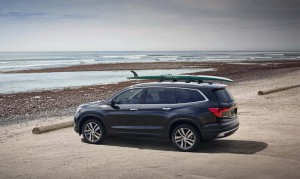
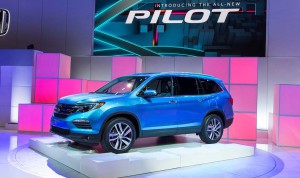
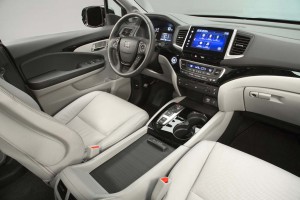
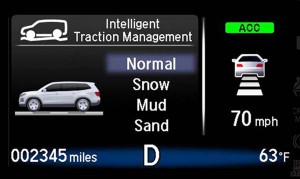
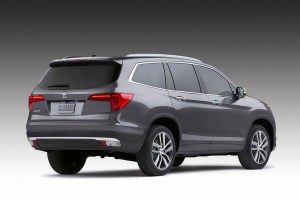
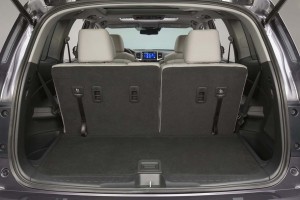
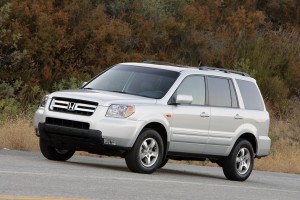
almost made it to the bottom of the article withouzzzzzzzzzzzzzz
not the writing’s fault, it’s that vehicle. So boring. But someone obviously likes it.